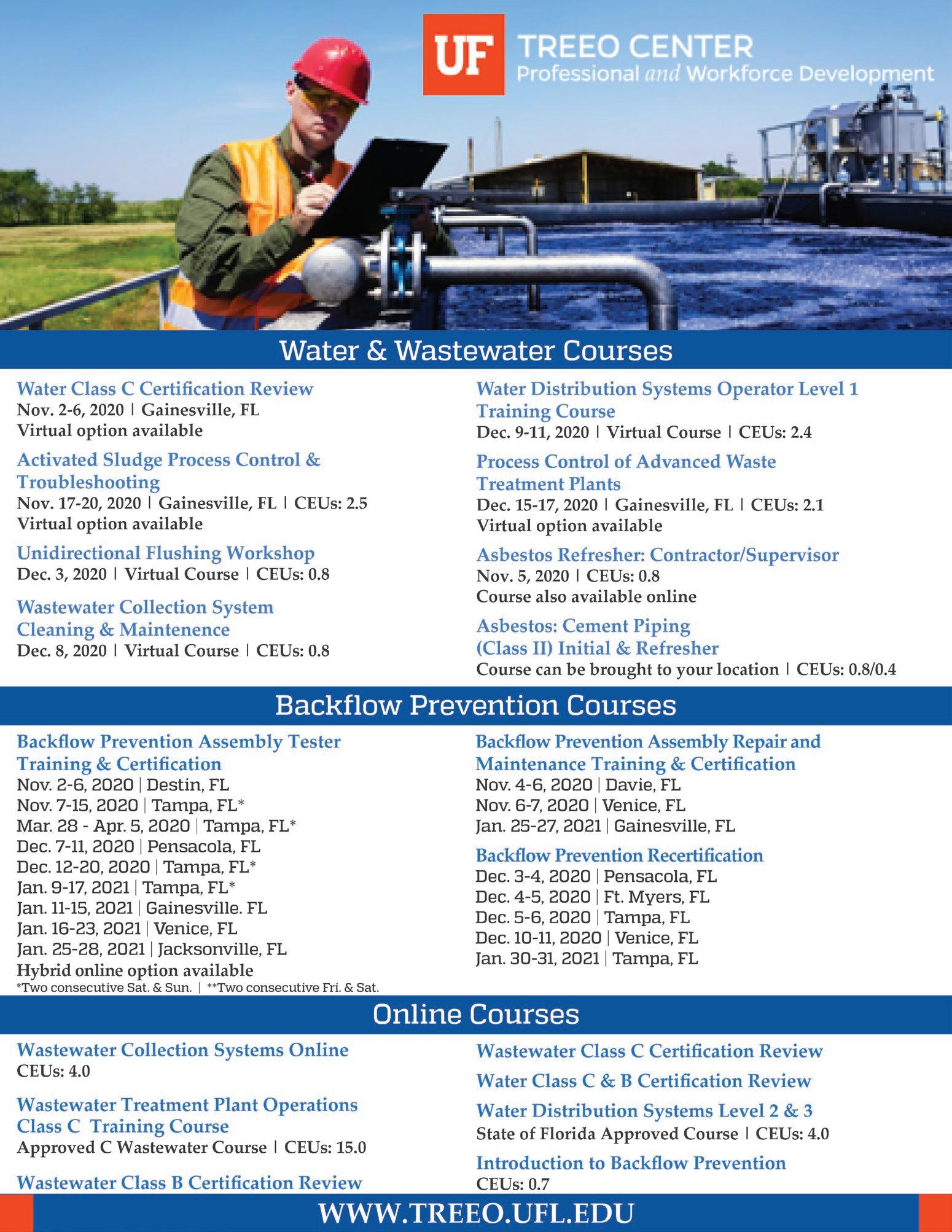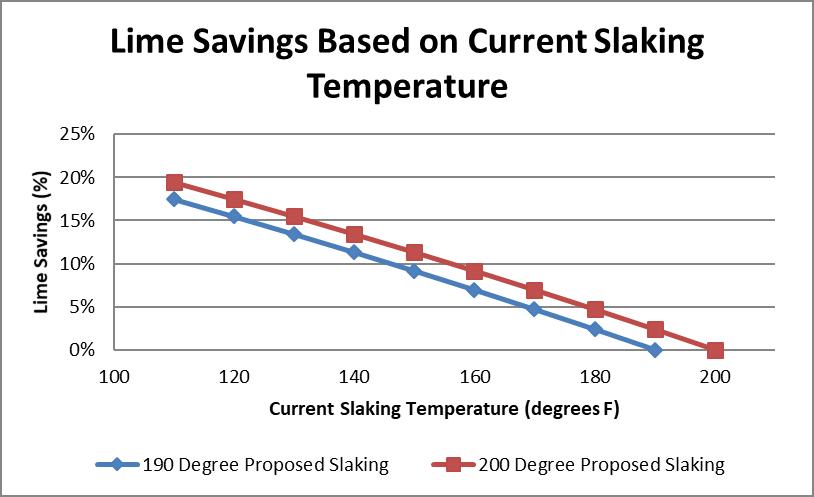
8 minute read
TREEO Center Training
Continued from page 46 calcium carbonate. Trying to do this by treating the filters with acids or proprietary cleaning chemicals is largely unsuccessful and can cause damage to the filters.
A lime dose directly relates to lime softening pH and overall solids production (adding calcium when adding lime, which also needs to be removed with the influent calcium). Figure 6 shows water quality results of four lime doses (expressed as CaO) tested at the bench scale for the city. The East WTP’s current average lime dose is 127.5 mg/L as CaO. (Note: water quality results from bench-scale testing of the 127.5 mg/L dose were similar to grab samples collected from the full-scale plant.)
Advertisement
As expected, as the dose increased to 136.6 mg/L as CaO, settled water pH increased and hardness decreased; however, no significant improvement in hardness reduction was achieved compared to the current average dose. The corresponding CCPP and LSI were also considered and are shown for each dose. A CCPP from 4 to 10 mg/L is preferred for settled water stability, and at lower lime doses this value decreases below this range. For this WTP, these results indicated that a settled water pH of 9.5 should be targeted to provide a stable settled water, which can be achieved at lime doses around 127.5 mg/L, depending on raw water quality.
For these reasons, it was not recommended that the lime dose be lowered. It also should be noted that the lower the hardness of the softened water, the more bypass that can be allowed, which yields greater cost savings than an overall lime dose reduction. Bypassing should also consider CCPP, LSI, and alkalinity of the finished water to confirm slightly precipitating conditions and a well-buffered, noncorrosive water to protect the distribution system.
As mentioned, the softening process relies on the presence of alkalinity. In cases where alkalinity in the source water is limited, increased lime doses above what is needed for the reaction can actually lead to increased hardness (since lime is Ca[OH]2), as shown in Figure 7. Therefore, it may be prudent to determine if a utility is inadvertently on the uptick of the chart (starting at 160 mg/L) and overdosing lime. The actual lime dose that this could occur at is unique to each utility, and finished water goals can be achieved by lowering the lime dose or adding soda ash (more carbonate) or caustic soda (no calcium addition) if the higher pH is necessary.
Solids Handling
The lime softening process generates calcium carbonate solids in the SCCs that need to be removed intermittently to maintain a desired concentration of solids within the softeners. The management of the percent solids in the center cone of an SCC is the key to producing excellent settled water quality. A common misconception about SCC operation is that the solids level needs to be above the outlet of the center cone (solids blanket mode of operation); however, this is not required and can be detrimental to settled water quality.
Solids (residuals) blowdown frequency has a direct impact on the solids inventory. Insufficient blowdown frequency leads to solids buildup within the SCC and places an increased strain on the internal equipment (such as the rake), which can potentially plug up the solids blowdown lines. Contrarily, if solids blowdown is too frequent, then valuable surface area provided by the solids are lost, which can contribute to compromised settled water quality because smaller particles form and carry over.
A utility in south Florida previously monitored percent solids from the primary mixing zone instead of the center cone, which did not provide valuable information on the solids inventory. Measuring the percent solids by volume within the center cone can help determine if the correct solids inventory is occurring, with 6 to 12 percent solids (by volume) being the target for most SCCs. If not in the ideal range, then modifying operations, including blowdown frequency and mixing speed, could improve the solids inventory and settled water quality. It should be noted that there are many SCCs in Florida that cannot handle the desired solids inventory due to poor mixer performance or limitations of the rake. Utilities should realize that some SCCs will not work correctly due to these limitations.

Lime Slaking and Handling
Effective and efficient lime softening relies on proper activation (assuming that the utility needs to slake the lime) of the lime. This is a process where pebble lime reacts with water to form calcium hydroxide and generates heat. Controlling this reaction (high heat without boiling) is important because the reactivity of slaked lime is dependent on surface area (more area for reaction) and maintaining a small particle size (small particles stay in suspension longer). Both higher surface area and smaller particle size are facilitated by high slaking temperatures.
Faster-reacting lime raises the pH and generates calcium carbonate more quickly, which results in limiting undesirable precipitation (in locations such as downstream piping, filters, etc.) and maximizing lime efficiency. Inefficient slaking can actually lead to higher lime usage and increased solids. Properly controlled slaking temperature provides optimum lime reaction conditions with small particles that have high surface areas and results in adequate surface area for reaction and slow settling lime particles.
Newly affordable infrared cameras provide a cost-effective tool that can be used to safely check the slaking temperature. The ideal slaking temperature range is between 190 and 200°F (although the slaking temperature should be based on the efficiency of the slaking and eliminating localized boiling). Operating temperatures below this range result in inefficient lime use, which is shown in Figure 8.
Operational modifications to control slaking include modifying the water-to-lime ratio to help control temperature. Slaking temperature, reaction time, and lime-to-water ratio also depend on the quality of lime and the starting water temperature; therefore, slaking temperature should be checked with each new load of lime (laboratory test procedures are available). The dilution water that is used to slake the lime typically has carbonate, which will react with the calcium in the lime and result in deposition. Utilities could also consider use of a lime slurry condition agent if the plugging of lime equipment is frequent, or, if severe enough, could consider an air stripping unit that converts the carbonate to carbon dioxide and then strips out the carbonate from the dilution water, resulting in no precipitation in the lime systems. There are also polyphosphate-based chemicals that can be added to the lime slurry to reduce deposition and maintenance of feed lines.
Conclusion
Many utilities throughout the state of Florida use the lime softening process to reduce hardness and color. Due to the complexity of the softening process, a majority of the fundamental knowledge and control aspects of the process have been forgotten; however, there are many operational modifications that these utilities can employ to optimize their lime softening treatment process (Figure 9).
Softening via the solids contact process is like a light switch—it’s either on or off, and control of the hardness from the process is limited, unless bypassing is an option. Utilities should consider the addition of color removal technology, which would decouple the lime softening process from color removal (that requires softening of 100 percent of the flow) and allow for the targeting of finished water hardness goals. In these cases, there would be an opportunity to bypass a portion of the flow around the softening process to help control finished water hardness and alkalinity, and reduce operating costs. An optimizing dose considering raw water alkalinity, finished water hardness, and alkalinity goals could help avoid overdosing of lime. Finished water corrosion indices like CCPP and LSI should be confirmed prior to any bypass or lime dose changes.
There is an opportunity to review currently installed SCCs in Florida to see if increases in upflow rates could be achieved that could provide an overall increase in process capacity. Additionally, utilities should consider adjusting the recirculation ratio (via mixing speed) to encourage a high volume and quality of solids within the center cone to improved settled
Figure 8. Potential Lime Savings Based on Potential Slaking Temperature Versus Current Slaking Temperature

Figure 9. Summary of Lime Softening Optimization Strategies

water quality. Optimizing the mixing speed in the SCC could also provide for reduced operating torque, resulting in extended life of SCC equipment.
Actively managing solids blowdown provides the opportunity to improve the solids inventory within the SCC, and a target of 6 to 12 percent solids (by volume) within the center cone is ideal. If solids are out of this range, then modifying operations, including blowdown frequency and mixing speed, could help achieve inventory, and ultimately, finished water goals. If the SCC cannot achieve these goals due to mixer or rake limtations, then the utility should consider replacing the equipment.
Finally, confirming the proper lime activation and slaking can help reduce overall lime usage. Utilities can modify the waterto-lime ratio (or utilize equipment with this inherent design feature) to control slaking temperature to the ideal range.
By re-examining the goals of the lime softening process to leverage existing SCCs, lime slaking, slurry systems, solids handling, and instrumentation, and implementing them in a cost-effective manner, allows for opportunities to re-align the process to achieve current-day goals and address legacy challenges. Utilizing these various techniques allows utilities to revive the lime softening process and also allows them to serve their needs, while reducing operating costs and improving finished water quality.










